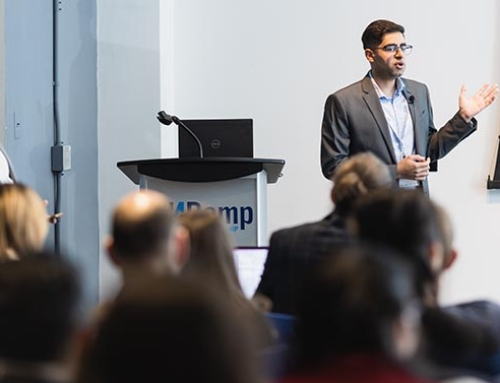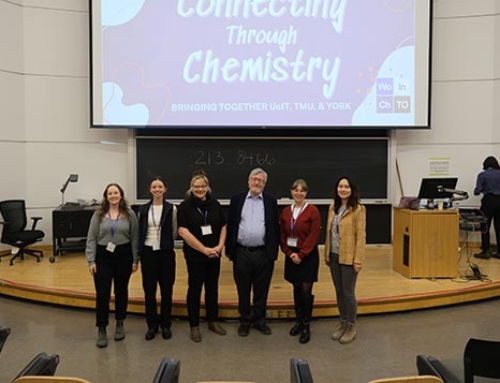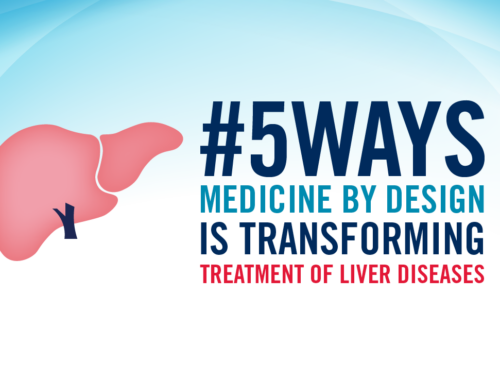
Trainees present their research posters at the 2016 Till & McCulloch Meetings in Whistler, B.C.
Medicine by Design sponsored 24 trainees to attend the 2016 Till & McCulloch Meetings (TMM) in Whistler, B.C., where they learned about the latest regenerative medicine research, presented their own work in plenary and poster sessions, and networked with researchers and trainees from across Canada and around the world. Here is what four of them said about their conference experience:
Mohsen Afshar

Mohsen Afshar attending the 2016 Till & McCulloch meetings.
Laboratory of Dr. Penney Gilbert
- What research did you present at TMM?
I presented a part of my PhD thesis project. In this project, I am attempting to model a human neuromuscular junction in a dish using 3D tissue engineering approaches to find novel therapeutics.
- How will attending TMM advance your research and your professional development?
I am not certain about my future career path, and TMM was a great opportunity to network with successful people from both academia and industry. It also provided me with a good opportunity to learn about similar and related research in my field that is being carried out in other institutions across Canada.
- What was the best part of TMM?
Plenary sessions were at such a high level and I found the question-and-answer sessions after each talk very helpful and encouraging. I found the networking sessions the most useful, since they helped me expand my network in my field of research for future collaborations.
Rebecca Mok

Rebecca Mok explores Whistler, B.C. while attending the 2016 Till & McCulloch meetings.
Laboratory of Dr. James Ellis, Hospital for Sick Children
- What research did you present at TMM?
I presented a poster on using neurons generated from induced pluripotent stem cells to model human disease in vitro. My graduate research focuses on investigating the altered morphology and function of neurons from individuals affected by the neurodevelopmental disorder Rett syndrome. We aim to identify molecules through drug screening approaches that can ameliorate the changes we observe in Rett syndrome neurons.
- How will attending TMM advance your research and your professional development?
The past three TMM meetings have been great opportunities to hear about all the work that is encompassed by the vast field of stem cell research, and be inspired by what I see to try to incorporate new techniques or other things into my own project. TMM also provides us with resources and workshops to learn more about the different job options trainees have for the next stage in their careers.
- What was the best part of TMM?
The best part was being able to attend sessions with a lovely mountain view as the backdrop!
Nika Shakiba
PhD Candidate, Institute of Biomaterials & Biomedical Engineering
Laboratory of Dr. Peter Zandstra
- What research did you present at TMM?
Recently, in the Zandstra lab, we have become fascinated with how competition between cells can drive population dynamics in the reprogramming process from skin cells to induced pluripotent stem cells. At TMM, I presented our approach to understand competition by combining a cell barcoding and mathematical modelling strategy to track reprogramming skin cells. To our surprise, we found that some skin cells were “elite,” meaning they are better at reprogramming than others and could actually out-compete their neighbours to take over the population. This challenges the current understanding in the field that all cells have equal reprogramming potential, and also teaches us the importance of using cell competition as a new lens to interpret population-level data sets.
- How will attending TMM advance your research and your professional development?
TMM is one of my favourite conferences because it fosters a strong Canadian stem cell network, inspires me to contribute to the ongoing Canadian stem cell legacy and connects me with fellow trainees who will be my colleagues in the future. TMM is a great place to share my research, welcome constructive feedback and learn from leading researchers with a wide variety of expertise, including molecular and computational biologists, clinicians, engineers, ethicists and biotechnologists. I always walk out of this conference with a refreshed insight into the field and a renewed passion for the research we do as a community. It keeps me motivated to continue to pursue my passion for my own research, knowing that it complements the hard work of my peers and other researchers in the field.
- What was the best part of TMM?
For me, the best part of TMM was the opportunity to interact with Canadian researchers who are eager to provide advice and mentorship. The Canadian network of stem cell scientists has a strong history of training the next generation of stem cell leaders. I have been lucky to have great support from my own supervisor, Peter Zandstra, and I was delighted to experience further dedication to mentorship through my interactions with various other experts at TMM. I am grateful for their feedback and advice, which has provided an additional layer of support in my training and professional development.
Samantha Yammine

Samantha Yammine (left) and Nika Shakiba were two of 24 trainees who received Medicine by Design Trainee Travel Awards to attend the 2016 Till & McCulloch Meetings.
Laboratory of Dr. Derek van der Kooy
- What research did you present at TMM?
I presented some of our work that identified quiescent stem cells in the adult mouse brain. While these cells divide very slowly in normal conditions, we’ve found that if you perturb their progeny they will quickly wake up from quiescence and start dividing to repopulate the lost cells.
- How will attending TMM advance your research and your professional development?
The Till & McCulloch meetings are just small enough to facilitate quality networking, but large enough to offer a great diversity in topics to make sure everyone walks away having learned something new. I appreciated the talks most outside of my comfort zone (such as the talk by Microsoft Research scientist Sara-Jane Dunn on Biological Computation and Bioethics of gene editing talk by Rosario Isasi) because they inspired me to think about the systems I study from a new angle. I also learned a lot professionally from the Meet the Experts lunch sessions, which exposed trainees to a variety of professionals in academia and industry. Overall the TMMs are great for learning new science as well as meeting new friends and mentors.
- What was the best part of TMM?
In terms of moments, I loved hearing the patient perspective from Tina Ceroni, a woman who benefitted from a stem cell clinical trial and is now actively involved in patient and research advocacy. One-on-one conversations during the poster sessions (while eating freshly made doughnuts and cookies!!) were another highlight.
More conceptually, one of the greatest things about TMM is how much the organizers and senior scientists encourage trainee engagement. On two occasions, I went up to ask a question in a plenary session and was given the opportunity to ask my question first, in advance of principal investigators who had beaten me to the microphone. I really appreciated having those opportunities since it gave me confidence that trainee input is valued, especially when the self-doubt starts to trickle in when all the eyes in the room turn to you.
The organizers also did a great job of encouraging social media coverage of the event, which I think is so important and often overlooked. Social media is a great way for scientists to meet one another and share ideas with those who could not attend the meeting in person, but also a great way to share the science we do with the public, which funds most of our research.





